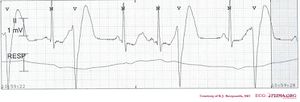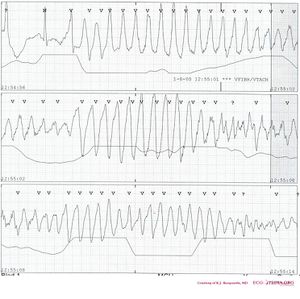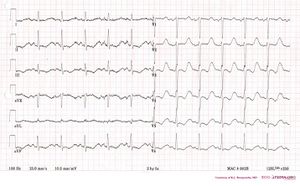Case 100: Difference between revisions
Jump to navigation
Jump to search
m (New page: Look at the consecutive ECGs in this patient. What is the problem? thumb|300px|left| ECG1 {{clr}} thumb|300px|left| ECG2 {{clr}}...) |
mNo edit summary |
||
| Line 1: | Line 1: | ||
Look at the consecutive ECGs in this patient. What is the problem? | Look at the consecutive ECGs in this patient. What is the problem? | ||
[[ | [[Image:KJcasu17-1.jpg|thumb|300px|left| Rhythm strip 1]] | ||
{{clr}} | {{clr}} | ||
[[ | [[Image:KJcasu17-2.jpg|thumb|300px|left| Rhythm strip 2]] | ||
{{clr}} | {{clr}} | ||
[[ | [[Image:KJcasu17-3.jpg|thumb|300px|left| Rhythm strip 3]] | ||
{{clr}} | {{clr}} | ||
[[ | [[Image:KJcasu17-4.jpg|thumb|300px|left| Rhythm strip 4]] | ||
{{clr}} | {{clr}} | ||
==Answer== | |||
* The first rhythm strip shows sinusrhythm with a severely prolonged QT interval. In total four ventricular premature beats are present on this strip. All fall within the T wave of the previous sinus beat. | |||
* | * The second strip shows [[Torsade de Pointes]] with a typical short (not shown) - long - short initial sequence. | ||
* The | |||
* | |||
* | |||
{{clr}} | {{clr}} | ||
Revision as of 21:35, 28 November 2007
Look at the consecutive ECGs in this patient. What is the problem?
Answer
- The first rhythm strip shows sinusrhythm with a severely prolonged QT interval. In total four ventricular premature beats are present on this strip. All fall within the T wave of the previous sinus beat.
- The second strip shows Torsade de Pointes with a typical short (not shown) - long - short initial sequence.
- The



